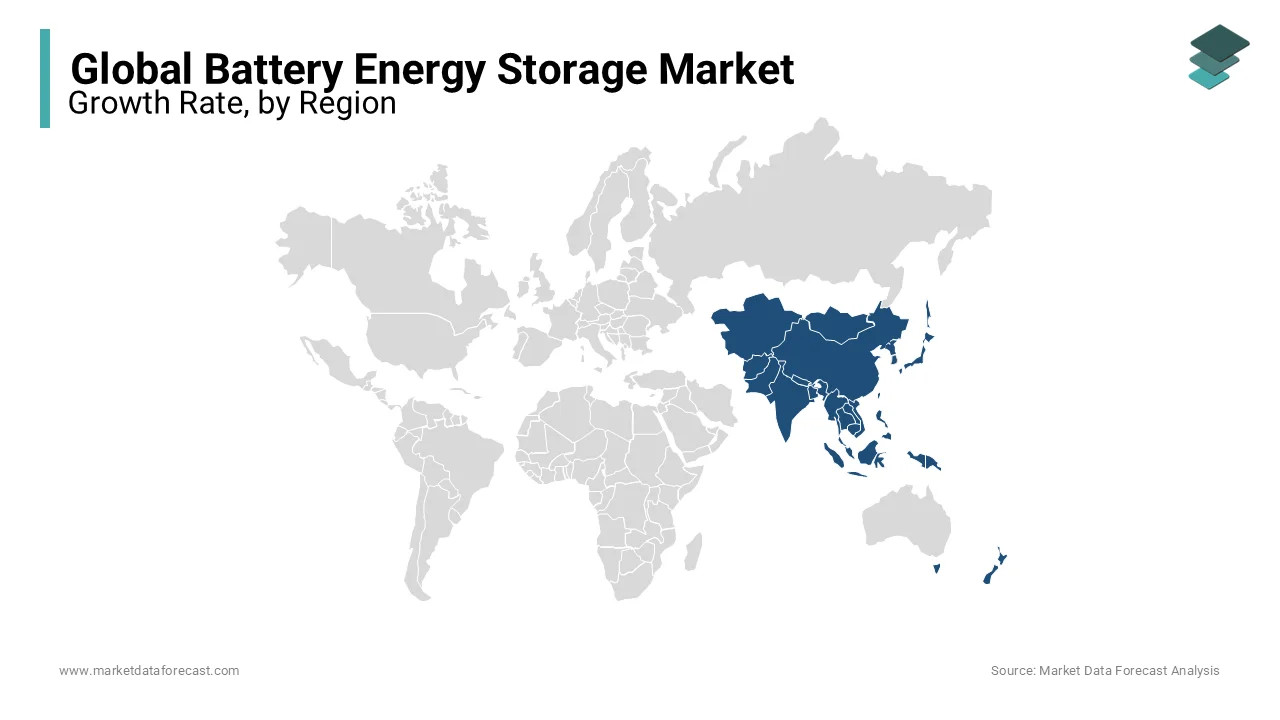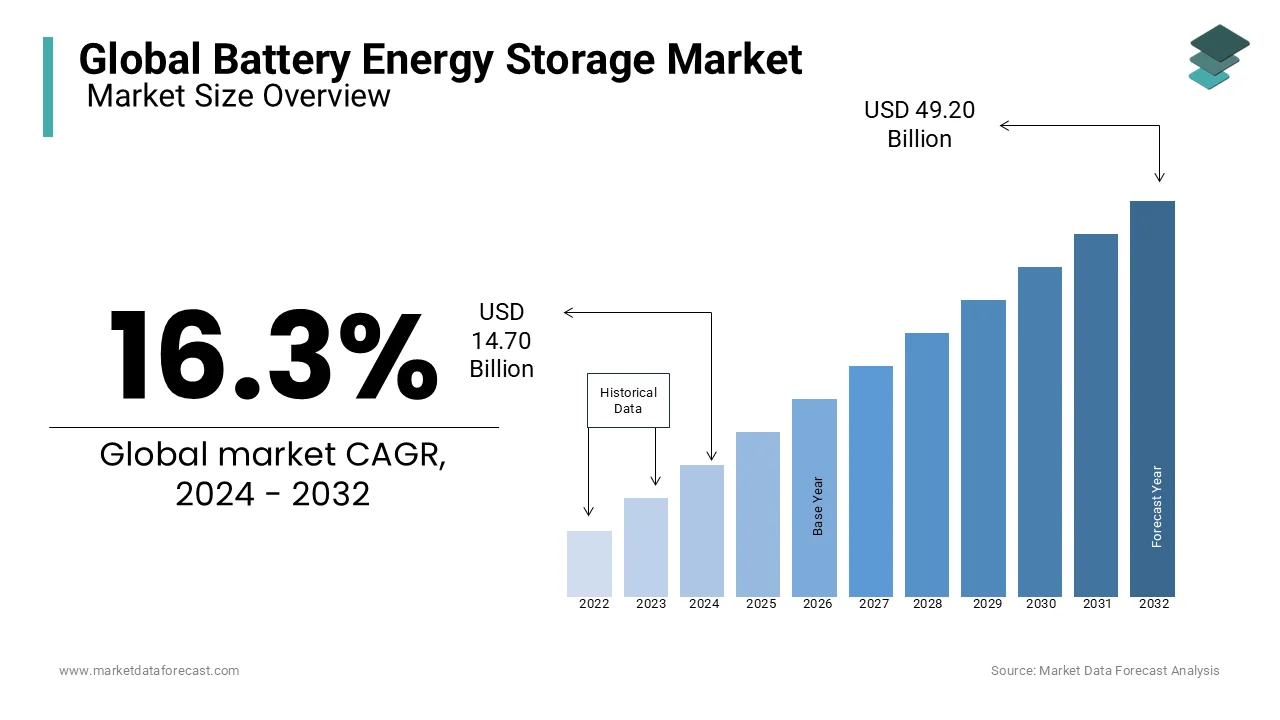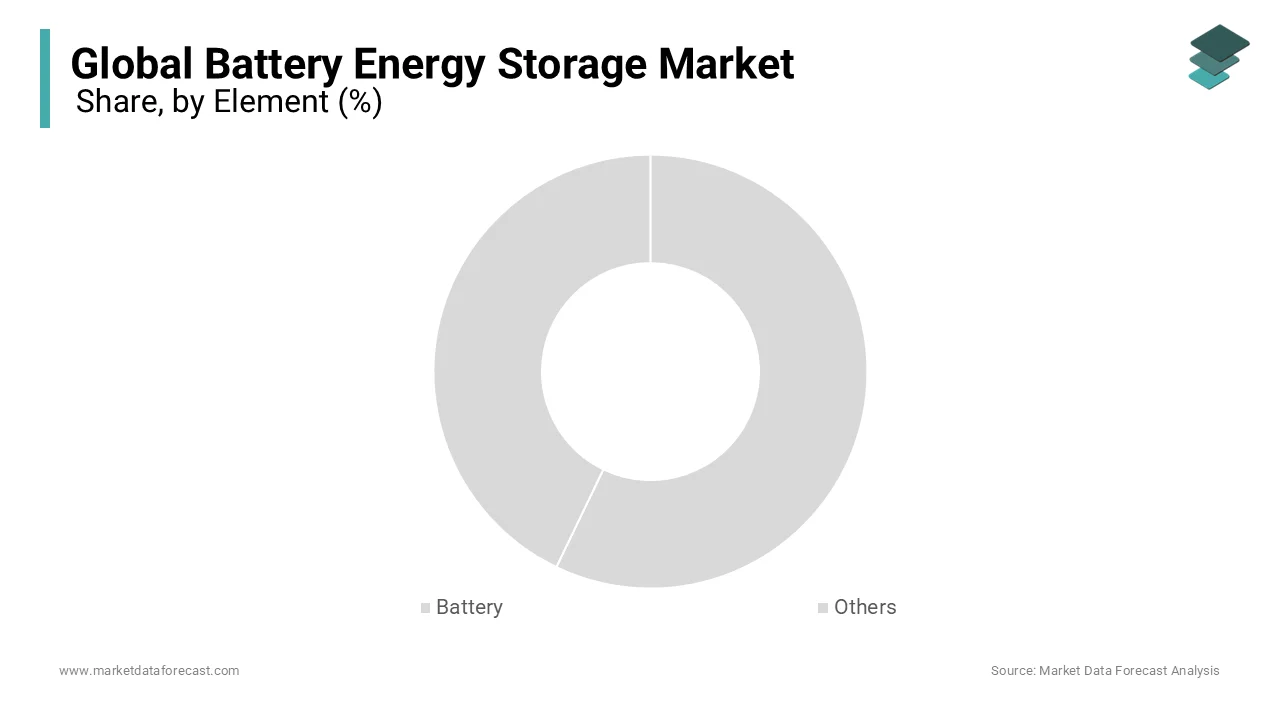Global Battery Energy Storage Market Research Report - Segmented By Element (Battery, Others), Battery Type (Lithium-Ion, Flow Batteries), Connection Type (On-Grid and Off-Grid), And Region (North America, Europe, APAC, Latin America, Middle East And Africa) – Industry Analysis From 2024 to 2032.
Global Battery Energy Storage Market Size (2024 to 2032):
The global battery energy storage market size is forecasted to increase from US$ 12.64 billion in 2023 to reach a valuation of US$ 49.20 billion by 2032 from US$ 14.70 billion in 2024 with a CAGR of 16.3% during the forecast period 2024-2032.
MARKET SCENARIO
Growing calls for continuous energy and electricity storage systems in critical infrastructure, adoption of grid energy storage solutions, and modernization efforts are supporting the global market growth. Network and escalating use of lithium-ion battery energy storage systems due to their excellent characteristics are among the factors that drive the market for battery energy storage systems. Battery energy storage systems can store energy from renewable sources such as the sun and wind. This means that the electricity grid can be supplied using clean natural sources, saving energy production costs and avoiding the dispersion of pollutants in the environment. Energy storage is an advantage due to its quick response, and compared to any fossil fuel, storage technologies can deliver energy much faster. This is an important advantage, especially when the call for electricity increases and exceeds the supply.
Battery energy storage systems help electricity providers save excess energy for later use, thus improving the flexibility and reliability of the grid in terms of electricity generation, transmission, and distribution. Furthermore, uninterrupted electricity calls are predicted to grow exponentially due to continued population expansion, infrastructure development, and rapid industrialization in the coming years.
Data centers use an uninterruptible power supply (UPS) to power loads in the event of an emergency when the main power fails. Battery energy storage systems play an important role in eliminating electrical fluctuations in data centers. The combination of inverter and battery energy storage systems ensures a continuous power supply to designated critical loads when grid outages or outages are detected. This leads to an increase in calls for UPS from large data centers. This, in turn, is predicted to fuel the call for energy storage systems based on lithium-ion and lead-acid batteries. The surveillance data collected and displayed by BMS is useful for data center operators.
MARKET DRIVERS
Solar and wind energy are the most important types of renewable energy stored in networks.
However, the hiding of the sun by clouds or fluctuating wind currents causes variations in the energy production process. These fluctuations create a call for flexible grid systems that are employed to store energy. Battery energy storage systems help grid operators save electricity when the electricity produced exceeds the call for electricity. The adoption of these systems improves the reliability and flexibility of the electrical supply systems with respect to the generation, transmission, and distribution of electrical energy. During transmission and distribution of electricity, battery energy storage systems can manage asset carry-over, provide frequency regulation, perform harmonic suppression, provide voltage support, and ensure diet quality. The delay of electrical energy, the leveling of the base load and the reduction of peaks, the change of time of the renewable energies, and the reaffirmation of the renewable capacity are other benefits offered by battery energy storage systems for solutions connected to the net. All of these factors are driving the adoption of the battery energy storage market.
MARKET RESTRAINTS
Battery energy storage technologies, including lithium-ion batteries, flow batteries, and lead-acid batteries, require higher installation investments due to the high energy density and improved performance they offer.
Lithium-ion batteries are expensive because they offer high energy density, low self-discharge rate, and require less maintenance. However, in the future, the costs of lithium-ion batteries are predicted to decrease. These batteries are also employed in electric vehicles (EVs) because they are light and compact, as well as high capacity.
Data centers use an uninterruptible power supply (UPS) to power loads in the event of an emergency when the main power fails. Battery energy storage systems play an important role in eliminating electrical fluctuations in data centers. The combination of inverter and battery energy storage systems ensures a continuous power supply to designated critical loads when grid outages or outages are detected. This leads to an increase in calls for UPS from large data centers. This, in turn, is predicted to fuel the call for energy storage systems based on lithium-ion and lead-acid batteries. The surveillance data collected and displayed by BMS is useful for data center operators.
The spread of COVID-19 has affected the energy industry supply chain, especially renewable energy technologies and battery energy storage systems. The main components employed in battery energy storage systems are made primarily from APAC. The pandemic has exposed the world's over-reliance on the region, especially China, for essential raw materials.
REPORT COVERAGE
|
REPORT METRIC |
DETAILS |
|
Market Size Available |
2023 to 2032 |
|
Base Year |
2023 |
|
Forecast Period |
2024 to 2032 |
|
CAGR |
16.3% |
|
Segments Covered |
By Element, By Battery, By Ownership, By Connection, By Application, and Region. |
|
Various Analyses Covered |
Global, Regional, & Country Level Analysis; Segment-Level Analysis, DROC, PESTLE Analysis, Porter’s Five Forces Analysis, Competitive Landscape, Analyst Overview of Investment Opportunities |
|
Regions Covered |
North America, Europe, APAC, Latin America, Middle East & Africa |
|
Market Leaders Profiled |
ABB (Switzerland), Panasonic (Japan), Siemens AG (Germany), Samsung SDI (South Korea), LG Chem (South Korea), General Electric (US), Hitachi (Japan), Tesla (US), Toshiba (Japan), AEG Power Solutions (Netherlands), The AES Corporation (US), Delta Electronics, Inc. (Taiwan), TrinaBESS (China), Primus Power (US), NEC Corporation (Japan), BYD (China), and Johnson Controls (US), and Others. |
SEGMENTAL ANALYSIS
Global Battery Energy Storage Market Analysis By Element
The battery segment dominated the worldwide market for battery energy storage systems during the review period, as it is a vital component of this system. The availability of different battery models as needed is driving the expansion.
Global Battery Energy Storage Market Analysis By Battery Type
Lithium-ion batteries represent the largest size in the market by battery type. The growing application of lithium-ion batteries in the consumer electronics and automotive industries is escalating their call.
Global Battery Energy Storage Market Analysis By Connection Type
Depending on the type of connection, the grid connection segment is likely to grow at the highest CAGR during foreseen years as it is employed to power consumers and reduce utility spending. Various features like power management, load leveling, spike reduction, etc., stimulate calls from the grid connection industry.
REGIONAL ANALYSIS

Asia Pacific (APAC) occupied most of the global battery energy storage market in 2019. APAC is a hub of the battery energy storage systems industry. APAC is predicted to witness electrification plans in remote areas, most of which are off-grid in various countries. The use of residential energy storage technology will improve access to electricity for these isolated and island communities in the region. Investments in energy storage are predicted to increase dramatically in the region as governments of growing economies develop new policies to improve the reliability and quality of electricity distribution facilities for residential customers. In addition to APAC, North America has a significant market share.
The expansion of the North American market depends on the escalating call for renewable energy storage systems in the residential, non-residential, and utility sectors. In 2019, the United States accounted for approximately 0.9 GW of installed battery energy storage systems. The main players in the region are companies such as Tesla, ABB, General Electric, and Honeywell, which focus on installing and supplying battery-powered energy storage systems. A portfolio of giant lithium-ion projects in the United States is predicted to be completed by 2021.
KEY PLAYERS IN THE GLOBAL BATTERY ENERGY STORAGE MARKET
ABB (Switzerland), Panasonic (Japan), Siemens AG (Germany), Samsung SDI (South Korea), LG Chem (South Korea), General Electric (US), Hitachi (Japan), Tesla (US), Toshiba (Japan), AEG Power Solutions (Netherlands), The AES Corporation (US), Delta Electronics, Inc. (Taiwan), TrinaBESS (China), Primus Power (US), NEC Corporation (Japan), BYD (China), and Johnson Controls (US) are some of the major players in the battery energy storage market.
RECENT HAPPENINGS IN THE MARKET
- Siemens launched its first storage battery tailored to people's needs. Owners can use the Junelight smart battery to maximize self-generated power consumption, minimize power supply costs, and reduce emissions.
- Northvolt launched a new battery energy storage solution, the Voltpack Mobile System, a robust and highly modular lithium-ion battery solution designed as a zero-emission alternative to replace diesel generators.
DETAILED SEGMENTATION OF THE GLOBAL BATTERY ENERGY STORAGE MARKET INCLUDED IN THIS REPORT
This global battery energy storage market research report has been segmented and sub-segmented based on element, battery type, connection type, and region.
By Element
- Battery
- Others
By Battery Type
- Lithium-Ion
- Flow Batteries
By Connection Type
- On-grid
- Off-grid
By Region
- North America
- Europe
- Asia Pacific
- Latin America
- Middle East & Africa
Related Reports
Access the study in MULTIPLE FORMATS
Purchase options starting from $ 2500
Didn’t find what you’re looking for?
TALK TO OUR ANALYST TEAM
Need something within your budget?
NO WORRIES! WE GOT YOU COVERED!
Call us on: +1 888 702 9696 (U.S Toll Free)
Write to us: [email protected]

